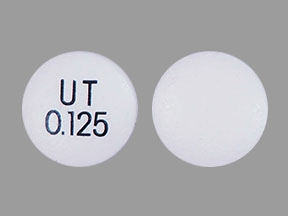Orenitram Disease Interactions
There are 7 disease interactions with Orenitram (treprostinil).
- Hepatic impairment
- Bleeding
- Diverticulosis
- Hypotension
- Liver dysfunction
- Pulmonary infections
- Renal dysfunction
Treprostinil (applies to Orenitram) hepatic impairment
Major Potential Hazard, Moderate plausibility. Applicable conditions: Liver Disease
The use of the extended-release tablet formulation of treprostinil is contraindicated in patients with severe hepatic impairment (Child Pugh Class C). There is a marked increase in the systemic exposure to treprostinil in hepatically impaired patients. It is recommended to start patients with mild hepatic impairment (Child Pugh Class A) at 0.125 mg BID with 0.125 mg BID dose increments every 3 to 4 days and to avoid use of treprostinil in patients with moderate hepatic impairment (Child Pugh Class B).
References
- (2017) "Product Information. Orenitram (treprostinil)." United Therapeutics Corporation
Treprostinil (applies to Orenitram) bleeding
Moderate Potential Hazard, Moderate plausibility. Applicable conditions: Bleeding Associated with Coagulation Defect
Treprostinil injection inhibits platelet aggregation and increases the risk of bleeding. Close monitoring is recommended when using this agent in patients with bleeding disorders.
References
- (2017) "Product Information. Orenitram (treprostinil)." United Therapeutics Corporation
Treprostinil (applies to Orenitram) diverticulosis
Moderate Potential Hazard, Moderate plausibility. Applicable conditions: Diverticulitis
The tablet shell of the manufactured form of treprostinil, Orenitram does not dissolve and can lodge in the diverticulum of patients with diverticulosis. Care should be exercised when using this drug in patient with diverticulosis.
References
- (2017) "Product Information. Orenitram (treprostinil)." United Therapeutics Corporation
Treprostinil (applies to Orenitram) hypotension
Moderate Potential Hazard, Moderate plausibility.
Treprostinil is a pulmonary and systemic vasodilator. In patients with low systemic arterial pressure, treatment with treprostinil injection may produce symptomatic hypotension. Care should be exercised when using this agent in patients at risk.
References
- (2017) "Product Information. Orenitram (treprostinil)." United Therapeutics Corporation
Treprostinil (applies to Orenitram) liver dysfunction
Moderate Potential Hazard, Moderate plausibility. Applicable conditions: Liver Disease
Severe hepatic impairment (Child Pugh Class C) is a contraindication in patients taking the oral presentation of treprostinil. Treprostinil is substantially metabolized by the liver, primarily by CYP450 2C8. Treprostinil injection clearance is reduced in patients with hepatic insufficiency. In patients with mild or moderate hepatic insufficiency, decrease the initial dose of treprostinil injection to 0.625 ng/kg/min ideal body weight, and monitor closely. Treprostinil injection has not been studied in patients with severe hepatic insufficiency. It is recommended to titrate treprostinil injection slowly in patients with hepatic insufficiency, because such patients will likely be exposed to greater systemic concentrations relative to patients with normal hepatic or renal function.
References
- (2017) "Product Information. Orenitram (treprostinil)." United Therapeutics Corporation
Treprostinil (applies to Orenitram) pulmonary infections
Moderate Potential Hazard, Moderate plausibility. Applicable conditions: Pulmonary Impairment
The efficacy of treprostinil inhalant has not been established in patients with significant underlying lung disease. Patients with acute pulmonary infections should be carefully monitored to detect any worsening of lung disease and loss of drug effect.
References
- (2017) "Product Information. Orenitram (treprostinil)." United Therapeutics Corporation
Treprostinil (applies to Orenitram) renal dysfunction
Moderate Potential Hazard, Moderate plausibility.
Treprostinil and its metabolites are excreted mainly through the urinary route. It is recommended to titrate treprostinil injection slowly in patients with renal insufficiency, because such patients will likely be exposed to greater systemic concentrations relative to patients with normal renal function. No dose adjustments are required in patients with renal impairment. Treprostinil is not cleared by dialysis.
References
- (2017) "Product Information. Orenitram (treprostinil)." United Therapeutics Corporation
Orenitram drug interactions
There are 321 drug interactions with Orenitram (treprostinil).
More about Orenitram (treprostinil)
- Orenitram consumer information
- Check interactions
- Compare alternatives
- Pricing & coupons
- Reviews (1)
- Drug images
- Side effects
- Dosage information
- During pregnancy
- FDA approval history
- Drug class: agents for pulmonary hypertension
- Breastfeeding
Related treatment guides
Drug Interaction Classification
| Highly clinically significant. Avoid combinations; the risk of the interaction outweighs the benefit. | |
| Moderately clinically significant. Usually avoid combinations; use it only under special circumstances. | |
| Minimally clinically significant. Minimize risk; assess risk and consider an alternative drug, take steps to circumvent the interaction risk and/or institute a monitoring plan. | |
| No interaction information available. |
Further information
Always consult your healthcare provider to ensure the information displayed on this page applies to your personal circumstances.


